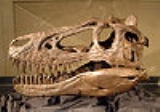
Nanotyrannus
Overview
Dinosaur
Dinosaurs are a diverse group of animals of the clade and superorder Dinosauria. They were the dominant terrestrial vertebrates for over 160 million years, from the late Triassic period until the end of the Cretaceous , when the Cretaceous–Paleogene extinction event led to the extinction of...
, known only from two juvenile specimens, which may in fact represent juvenile specimens of the contemporary species Tyrannosaurus rex.
Nanotyrannus is based on
Holotype
A holotype is a single physical example of an organism, known to have been used when the species was formally described. It is either the single such physical example or one of several such, but explicitly designated as the holotype...
CMN
Cleveland Museum of Natural History
The Cleveland Museum of Natural History is a natural history museum located approximately five miles east of downtown Cleveland, Ohio in University Circle, a 550-acre concentration of educational, cultural and medical institutions...
7541, a skull collected in 1942 by David Hosbrook Dunkle and described by Charles W. Gilmore
Charles W. Gilmore
Charles Whitney Gilmore was an American paleontologist, who named dinosaurs in North America and Mongolia, including the Cretaceous sauropod Alamosaurus, Alectrosaurus, Archaeornithomimus, Bactrosaurus, Brachyceratops, Chirostenotes, Mongolosaurus, Parrosaurus, Pinacosaurus, Styracosaurus and...
in 1946, who classified it as a new species in the tyrannosaur genus Gorgosaurus
Gorgosaurus
Gorgosaurus is a genus of tyrannosaurid theropod dinosaur that lived in western North America during the Late Cretaceous Period, between about 76.5 and 75 million years ago. Fossil remains have been found in the Canadian province of Alberta and possibly the U.S. state of Montana....
as G.

